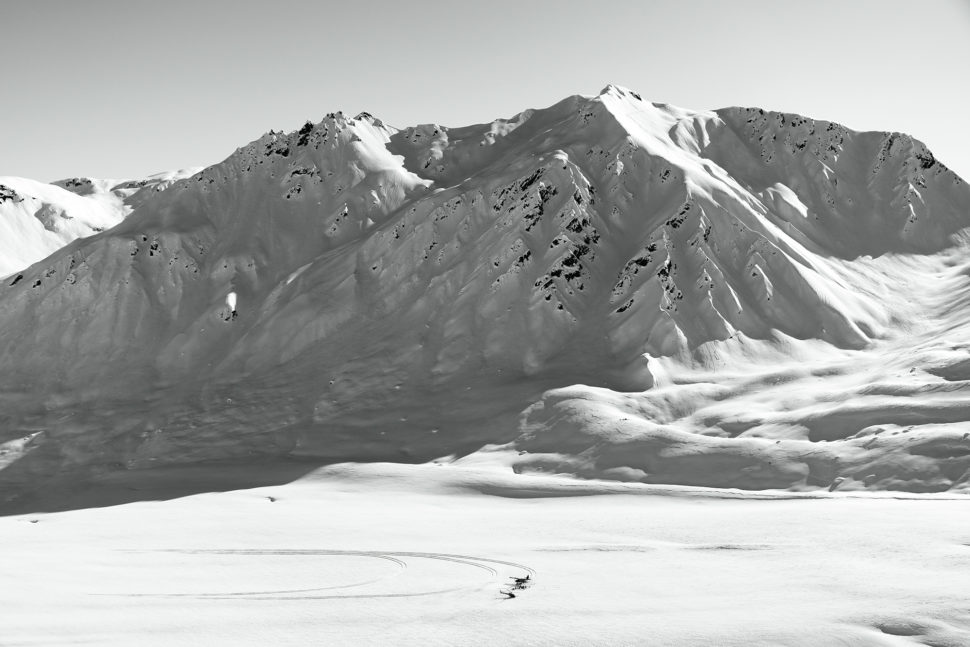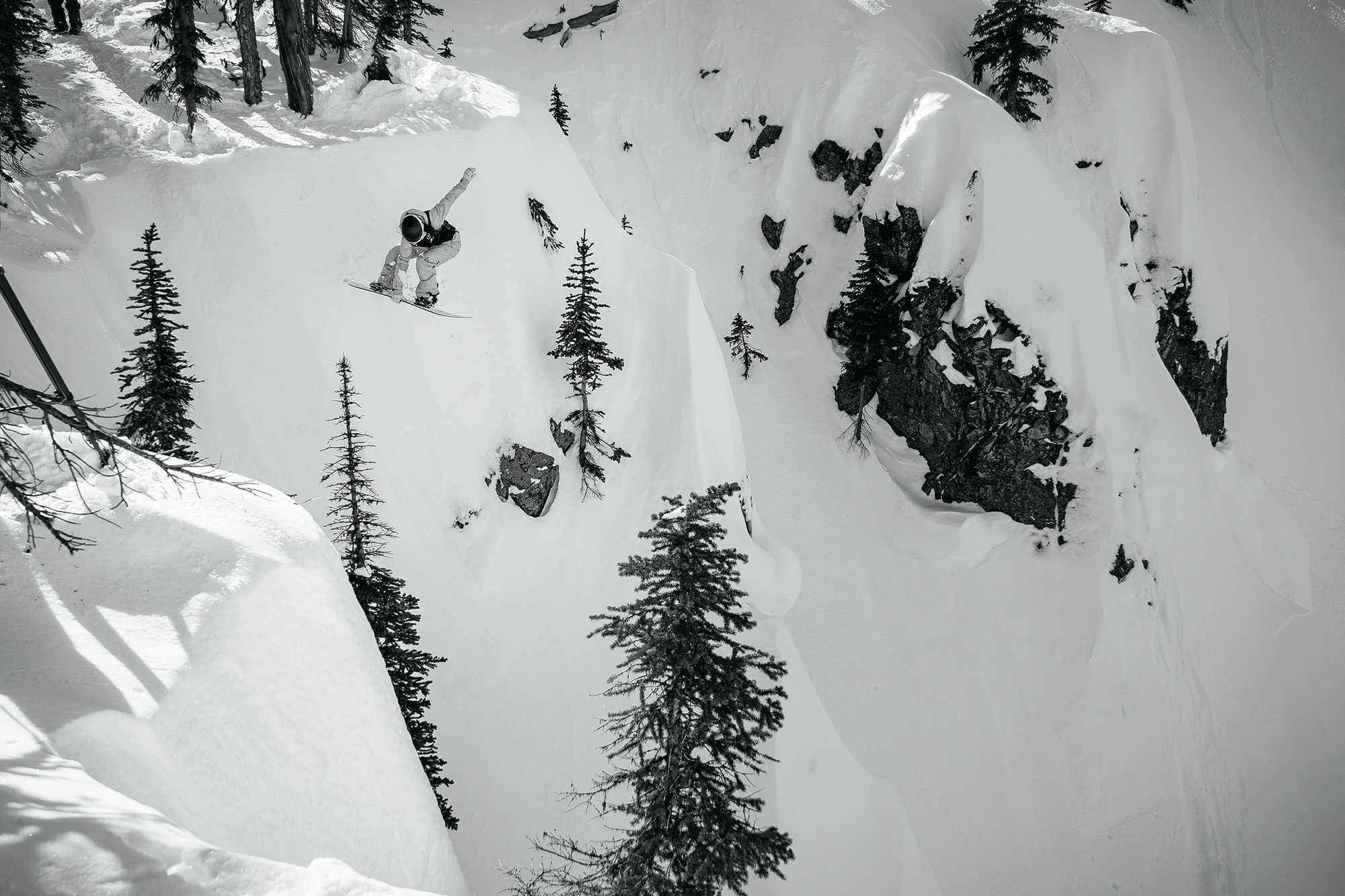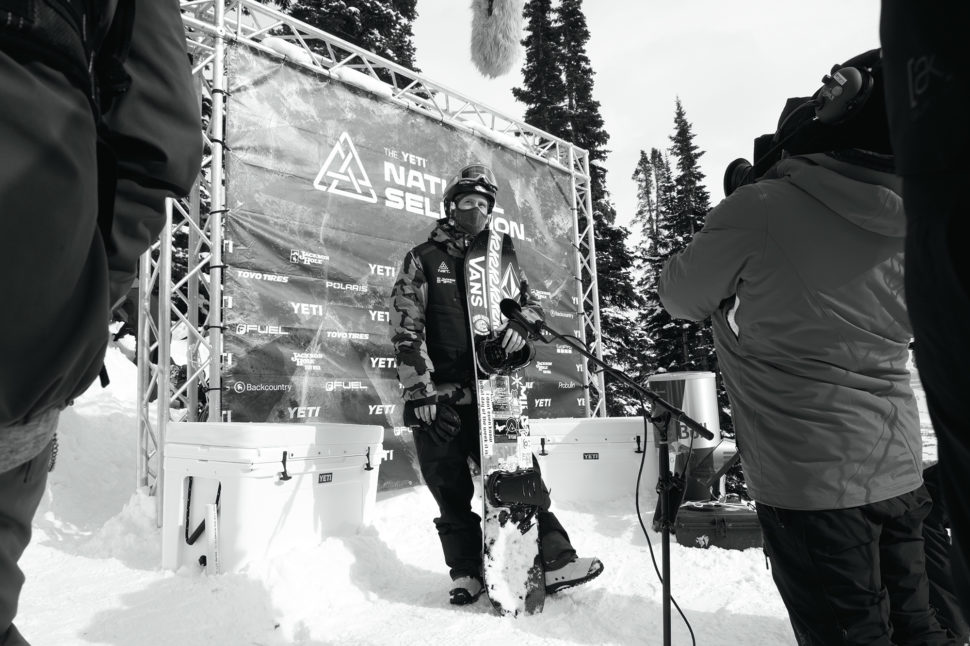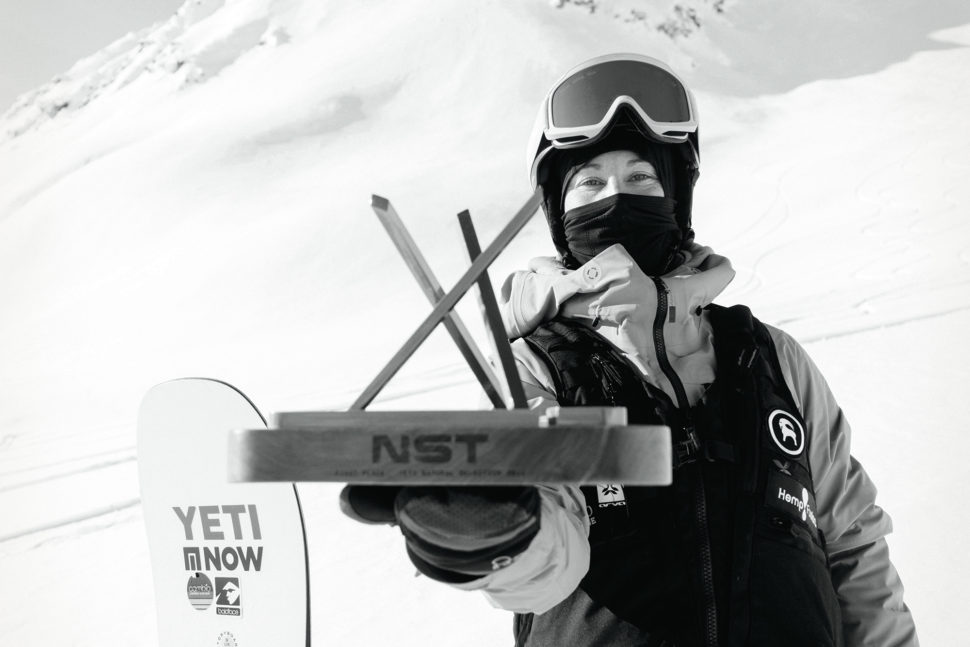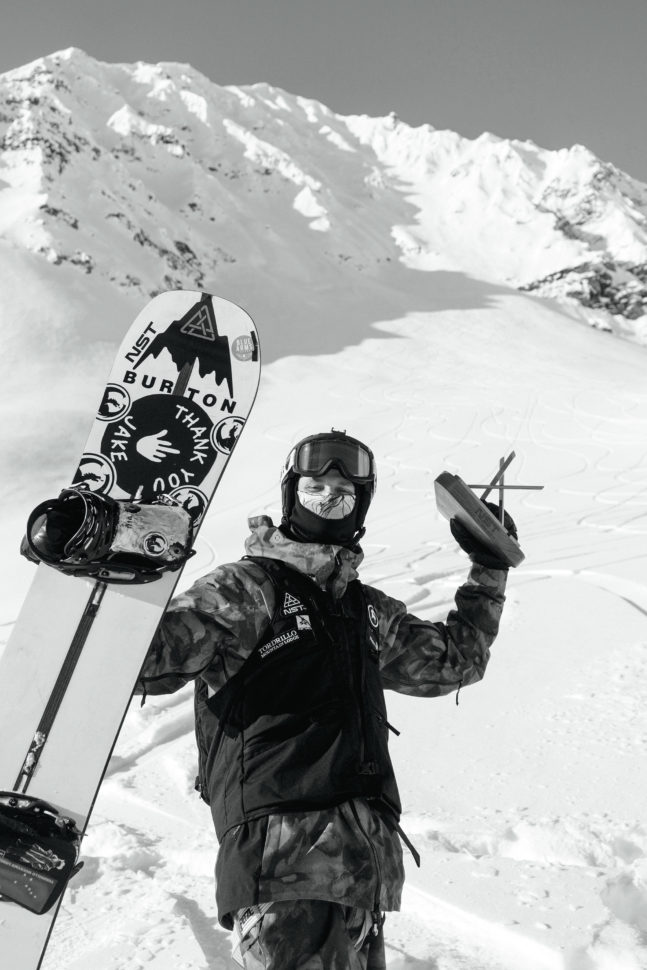Products You May Like
A Conversation with Travis Rice, Liam Griffin, and Circe Wallace.
THIS IS THE PLACE THAT I THINK SNOWBOARDING’S ALWAYS BEEN GOING AND IT HADN’T BEEN DONE YET BECAUSE IT’S REALLY FUCKING HARD, IT COSTS A LOT OF MONEY, AND YOU NEED CERTAIN TECHNOLOGY TO PULL IT OFF. SO, IT’S TAKEN THE TIME IT HAS. OF COURSE, THIS EVENT WOULDN’T BE SHIT WITHOUT ALL THE RIDERS SHOWING UP TO BE A PART OF IT.
— TRAVIS RICE
Last season, over a decade of inspiration, motivation, challenges and breakthroughs, setbacks and steps forward, drive, grit, and unflagging determination culminated in the first-ever Natural Selection Tour, a three-stop contest at the apex of freeriding and freestyle, driven by the relentless passion of Travis Rice. For years, Travis has worked in tandem with Liam Griffin, NST co-founder, an individual who has built the foundation for a multitude of snowboarding’s most highly regarded events and contests; Circe Wallace, Travis’ long-time collaborator, confidant, agent, and NST executive producer; and a dedicated crew that includes NST CEO Carter Westfall, Tom Monterosso, Uncle Toad’s Media Group, and many more, who were all dedicated to bringing a shared vision to fruition.
In February of 2021, all of their efforts were unleashed at the Yeti Natural Selection at Jackson Hole. It was
a perfect storm: two bluebird days of competition between a line-up of the best snowboarders on the planet, a massive storm system that provided a total reset in between semis and finals, and a rapt audience that was glued to the event from first drop to final run. Jackson was a palpable shift in what we expect from a snowboard event and the momentum continued to Baldface Valhalla in British Columbia and then to Tordrillo Mountain Lodge, where the finals took place in the steeps of Alaska.
Great things don’t come easily and Travis, Liam, and crew were faced with plenty of unexpected hurdles over the past year, not the least of which was taking a host of extra measures to run a multi-stop contest amidst a pandemic. But they made it through, not only unscathed but triumphant, and then immediately set their sights on the 2022 season, taking what they’ve learned over the past year—the past thirteen years, really—and applying it to further finetuning and evolving what they have created.
When it comes down to it, there is an incredible amount that goes into Natural Selection. And
while NST is truly dictated by the whims of Mother Nature and the opportunities provided by the Earth’s topography, the work behind the scenes is a compilation of meticulous details that complement the ever-changing and unexpected nature of well, nature. If there is a person best suited to walking the knife’s edge between the calculated and the chaotic, it is Travis Rice, and along with Liam, Circe, and the rest of the NST crew, he shifted the paradigm in snowboarding. As we head into winter, Travis, Liam, and Circe let us in on the calculations they made that brought the Natural Selection Tour to life. – Mary T. Walsh
IDEA AND DESIGN
I’M PASSIONATE ABOUT THE CREATION OF THE VENUES, FINDING THE LOCATIONS, AND MAKING THIS LARGE SCALE, MEGALITHIC FINE-ART INSTALLATION THAT IS NATURAL SELECTION. THE ART COMPONENT OF THIS IS SO DYNAMIC BECAUSE OF THE INTERACTION; YOU CAN CREATE SUCH A SCULPTURAL PIECE THAT PUSHES THE MOST FLUENT RIDERS ON THE PLANET TO FIND RHYTHM WITH IT.
— TRAVIS RICE
TRAVIS RICE: Originally, leading up to the first iteration in 2008, the Natural Selection, the idea behind the event was, “All right, how do we do a film?” because I’ve been making films every year—that was my passion. I remember also being inspired by the Arctic Challenge and overall experience of the event that Terje and his team pulled off. So at that point, the question was, how do we bridge the gap and make this dream event that is about pow and amazingly fun freeriding, and still has a freestyle underpinning and emphasis. We started to solidify the concept of how we wanted to run the first event over a decade ago, and Quiksilver and Jackson agreed to support it. Boom, we had our event. So, we did the original Natural Selection. It turned out to be one of the biggest weeks in the history of Jackson; I think we got ninety inches of snow over the course of the week. We had two venues, Dick’s Ditch and Casper Bowl, and we brought in this crazy cable cam to follow the riders down Dick’s Ditch. That was pre-drone, so it was kind of the prototype of what we have with Gab and drones in the tour now.
It was a great event, but I’m critical—I’m a realist. The riding was still not on par with what was in a video part. In reflection, it dawned on me just how important the terrain is in terms of what is possible for riders to do. It’s really hard to compete with the fact that in a film, you go out to a specific single location with an amazing feature, you ride that feature and film it, and then you pack up and you travel to the next specific spot that’s worthy of making it in a film.
You can’t compete with that because there are literally only a few venues on the planet that naturally have what’s needed for the Natural Selection type of contest. And so, I took a step back and realized that to really do this, we needed to get in and do work in the summertime to enhance the natural terrain. So that began the quest to find the Supernatural venue. I looked all over the Northwest, I looked in the Rockies, I looked in Interior BC. I would always be looking and taking photos when we were on riding trips, on sightseeing trips, on hunting trips, on plane flights. I found some really cool spots, but then came in the reality of “Okay, how remote can we go and pull this event off?” That was the next reality check.
Gabe Langlois was the one to recommend the Scary Cherry face at Baldface. At the time, I hadn’t been there. I hadn’t met Jeff Pensiero. We were shooting Art of Flight and weather came in. We did an emergency stop at Baldface and that’s when I met Jeff. The next day we looked at the venue and it was so appealing that I started painting the vision for Jeff. He is a snowboarder. He gets it. So we really looked into the logistics and set the plan in motion. The first year, we had about eighty features, the jump on the bench, and more features below. It’s literally a mile-long venue; it’s massive. And then we proceeded to have two really amazing years running the event there, in 2012 and 2013.
I think what was been a big evolution, is that in the beginning, the concept really came from the riding itself—the performance side of the snowboarding. Fast forward to Supernatural and Ultra Natural, and we were trying to build out more of a narrative about the locations—some of the science that comes into the snowpacks, avalanche, and hydrology. We had these initial ideas and then through pursuing the Fourth Phase film, that was when I started to realize that what’s really going on is a little bigger and much beyond just the riding side of things, in terms the bigger narrative and being a little more, I think, honest about what it takes to make a snowboarding film, versus just “We stomped shit, we fucking partied hard, and we ruled.” Because that’s only half the story. I’ve always been intrigued with self-education, so as we began to put the building blocks together for the Jackson event in 2021 and then the tour, it really became a no brainer.
As we got further into it, we realized that what was motivating us to do this was being able to have these educational components to give back and further instill a sense of responsibility and stewardship. I think you become aware of your power and responsibility, and the impact that we all have as you get a little older, and it became very apparent that the most important part of what we were doing was actually not the snowboarding. It was that with the snowboarding, we can create the relevancy, and the importance to tune in, because that was what was going to draw people.
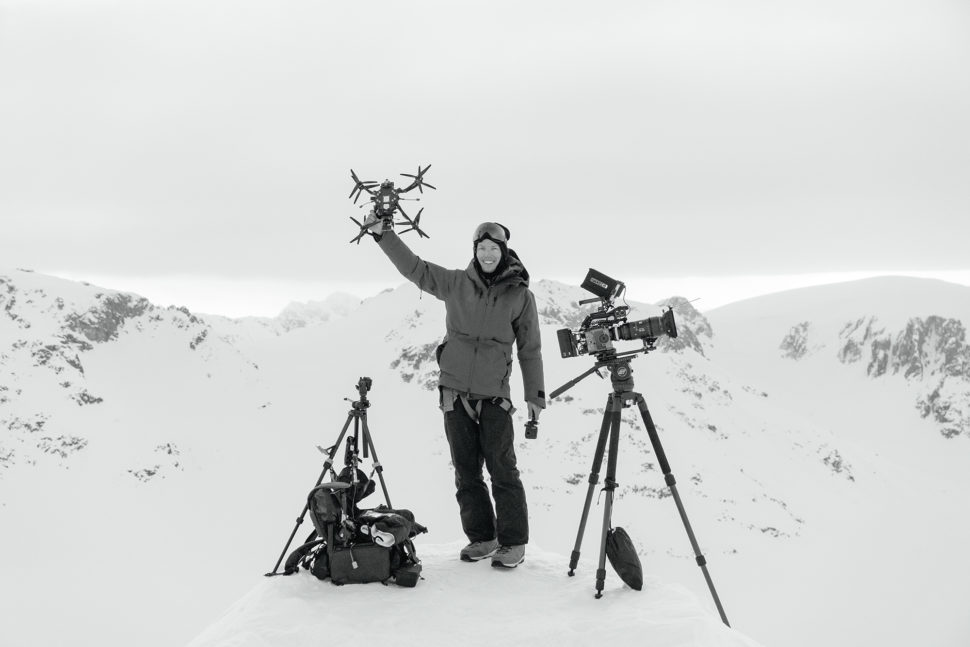
LIAM GRIFFIN: We saw that in general, the location had gotten lost as a character in the story. Most snowboard events right now, it doesn’t matter where they are. The halfpipe’s going to look like a halfpipe. The slopestyle is going to look like a slopestyle. There are no bad courses anymore. The builders are doing an insane job making courses that are so dialed that people can go anywhere and do whatever tricks they want to do. But in the process of that happening, the locations have become almost irrelevant.
Meanwhile, we’re in Jackson Hole, Wyoming because the terrain lends itself to progressive, freestyle, backcountry riding. Like in so many snowboard films you’ve watched over the years, there’s a jump session in the Rockies that starts out the part. Then it moves to BC where things ratchet up a notch and they start riding bigger, gnarlier pillow lines. Then the ender in your video part, if you’ve got the budget, is AK. That’s how your season goes. Go watch any of the big budget snowboard films—it’s Jackson, BC, Europe, Japan, Alaska. That’s your story arc. Those locations matter to snowboarding and so those locations are characters in the Natural Selection story to hopefully inspire people to learn about seek out those places. We did whole produced segments on: Why does this area get so much snow? What is the reason for the weather here? Why is this place important and how did it become that way? Just being able to explain to the viewer the “why” of all of this because it’s really important. We want people to leave the show knowing a little bit more and feeling a little bit more connected to the place than they did when they first tuned in.
CW: We’re all snowboarders. So adding these textures in, with us really coming from this space, we were able to identify and share what it is about snowboarding and being in these environments that is so wonderful and interesting and exciting, and then package that in a way that someone who’s never been on a snowboard, or might not ever be, can experience it, too. It’s almost like you can let it breathe and there is emotion and it feels beautiful. I think we did a really good job of that—I have nothing to do with that, right? I’m just a producer. I help get the resources to pull it all together, but I really think it’s a testament to all of us. We’re all snowboarders. It’s philosophical at that point, I think. We’re not trying to be something we’re not, and I think the real turning point for us in finding out how we get a bigger audience on this type of snowboarding was in bringing nature into your living room in an authentic way.
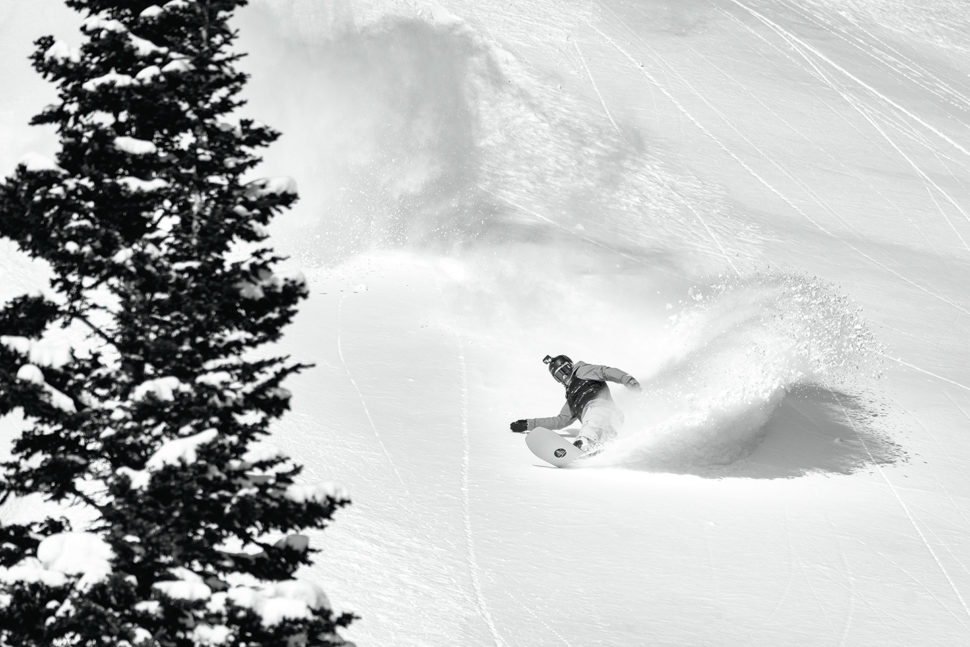
PROTOTYPE AND DEVELOPMENT
TR: Well, I think that the prototype piece is 2008 to 2012 and 2013. Those were the prototypes.
CW: These events were all experiments that allowed us to gather the data and information that we needed to figure out how to do it right. Collectively, I think that’s really why it was so good. It wasn’t just this past winter, “Oh my god, you did this amazing thing.” It’s like, “Yeah, well thirteen years…” All three events really taught us how to do things and of course, technology caught up with us.
LG: I think there are three big pieces that differentiated the 2021 tour from previous iterations of the event. The big evolution of this past year compared to any of the alpha or beta versions was that it was live. Figuring out “how do we do a contest in the backcountry live” is a way bigger lift than shooting a film or shooting a competition to tape, which we had done with previous iterations of the event. There’s that whole tech story of how you figure out how to connect all those cameras from where they were up in the mountain down to a parking lot miles away and be able to send a fully polished show out to the world, live.
Then there was the drone angle. Travis had this vision— for lack of a better term, we’ll call it the video game angle. Anyone who played Shaun White Snowboarding, or Amped, or Mark McMorris’s video game, you know that angle. The closest Travis had gotten was in Depth Perception, where he had a GoPro Karma Grip on a pole, and followed Austen Sweetin, Bryan Fox, and Robin Van Gyn for some key shots in that film. So figuring out how you shoot that live—you can’t use a follow cam because you don’t need an extra track in the course, but the drone to do that didn’t exist.
TR: There’s kind of been, for me anyway, these epochs of filming in terms of the tools that we have to try to change the perspective of the viewer and evolve the films that we spend so much time and effort on creating. Without a doubt, the format that we used for Community Project was a different format. And then That’s It, That’s All was about bringing in Shotover and giving an incredible natural history component along with use of slow-mo cameras. Then I think Fourth Phase was kind of taking that to a whole other level. As GoPros continued to get better and better, the POV component started to be a real thing. I remember, it was around the Supernatural or a year or two before that, I was still riding for Contour camera at the time. I remember putting a Contour on a painter pole and following Nate Bosshard down Baldface. That kickstarted this many-year evolution of follow camming. And of course, gimbals. There’s a shot, actually, in Depth Perception of a chute that I followed Bryan Fox down. It looked so perfect and unreal. It was such a dreamy shot. It wasn’t super extreme, it was just really beautiful, and we decided, “This is how the whole event’s going to look.” But we hadn’t actually figured out how to do it yet.
I think Torstein was the first snowboarder to work with Gab Kocher; they did a couple projects together. There’s a difference between filming for a movie and the type of filming we needed. Gab can go so crazy with his flying, but we wanted it really smooth and consistent. Gab custom-built the drones to do it.
LG: He has a PhD in engineering. He taught himself how to build gimbals and how to 3D print, and he built a custom gimbal for this drone. He figured out the drone platform, how all the transmission would work, how the gimbal would work, and had to have it all actually work by February for the event.
TR: He came out with his partner to Jackson and we did tests. Shit didn’t work. The network wasn’t working and we were having issues with the drone. That was like a month and a half before the contest. Gab and his partner just buckled down, spent a bunch of time, and ended up solving the issues—and it worked pretty flawlessly for the entirety of the event. I mean, in post, we nitpicked the shit out of it and there’s a lot of room for improvement, but for a first stab, I think it went really, really well.
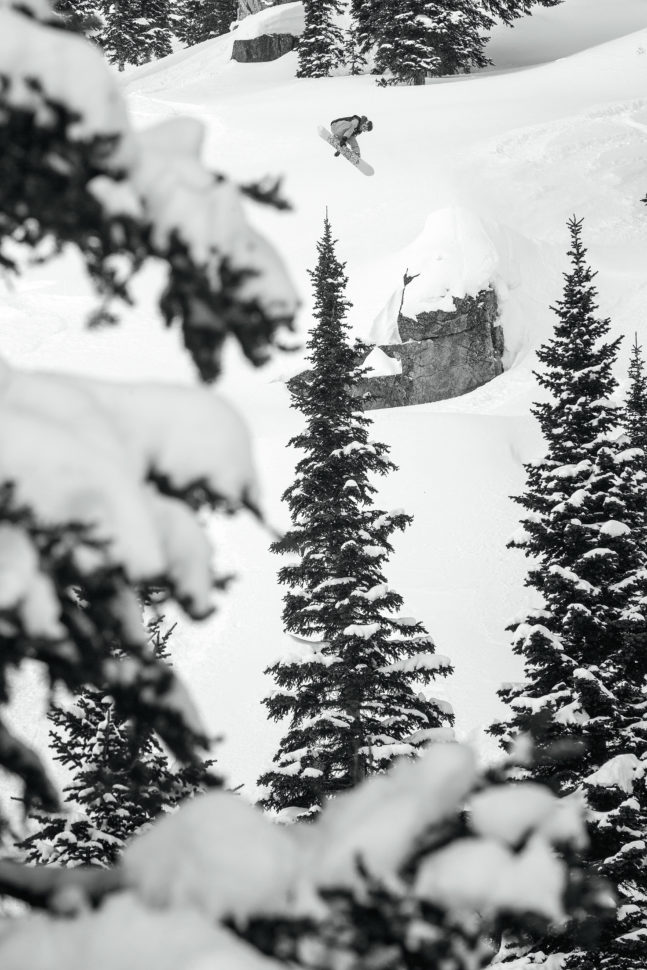
LG: It’s this magic of being able to be tight to the rider above them. You saw so much. It got even better for BC and AK. We had things we could do in BC and AK that we couldn’t do in Jackson because those events weren’t live, so the AK footage is fucking insane. Usually with AK videos, you’re used to seeing Cineflex or Shotover heli shots, which are kind of like high and wide tracking shots, or a Barbie angle where it’s just a little ant person going down a line shot from the other side of the valley. But all of a sudden with Gab flying the drone, you were right on top of the rider.
CW: It’s all the rider’s perspective, and to be able to share that with people who have never been to Alaska, or who are never going to do a top to bottom run on Scary Cherry, but who can get the feeling and the experience of that—it’s just so fun to be able to deliver that to people sitting at home.
TR: And a lot of people worked on each show to make that happen. Hats off, especially, to Uncle Toads Media Group. They were the ones who put it all together.
CW: They’re the best in class.
LG: So, there’s the live piece. There’s the drone piece. Then the other big piece, and this was a hundred percent Travis: the head-to-head heat format. There had been head-to-head formats in snowboarding before, but not in an environment like this.
TR: This wasn’t the first time that there has been a head-to-head event. The Air & Style did it, though it was a kind of a different format.
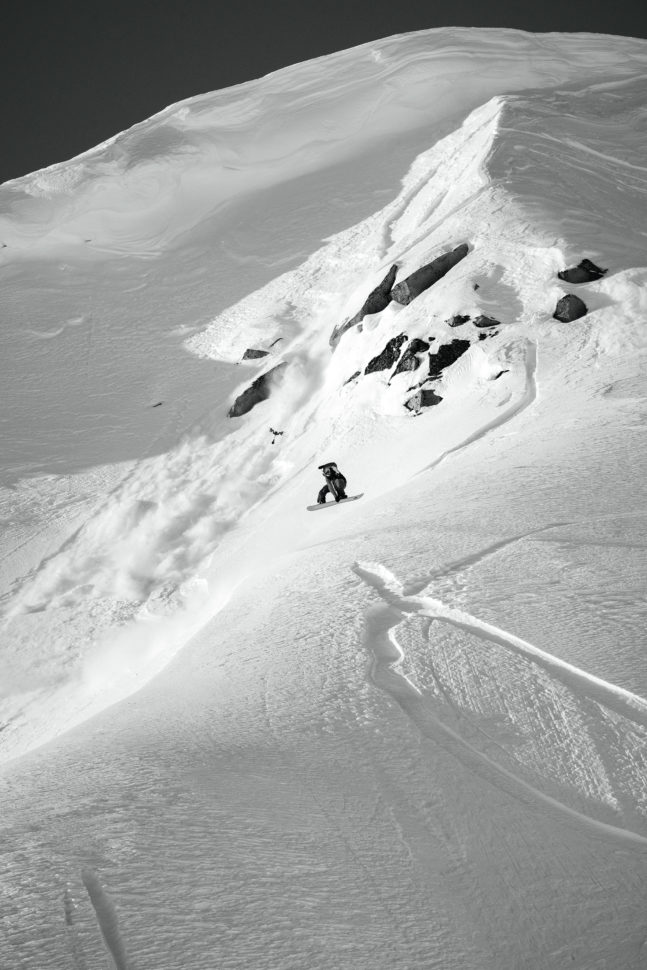
LG: The whole idea behind the head-to-head format was to build a way of running this competition in digestible little bites where anybody watching could pick a favorite and then follow that storyline from start to completion in a digestible little chunk.
TR: The rider draw for bracket positioning this past year in Jackson was so dynamic. I don’t think anyone was looking beyond the first head-to-head. It’s a new thing. People aren’t used to it, but I think a lot was learned and when we do the seeding event this coming season, it’s going to be a whole other realm of the riders being like, “Okay, hold on. Let’s really take a look at this”—not only who they’re facing off against in the first round, but down the line.
LG: And going back to how digestible the format made the show, if you win, you advance to the next round, and then you’re in another bracket with another person, and you start that little miniature story over again with two new characters. For viewers, it’s really entertaining, easy to follow and understand. You were always rooting for somebody.
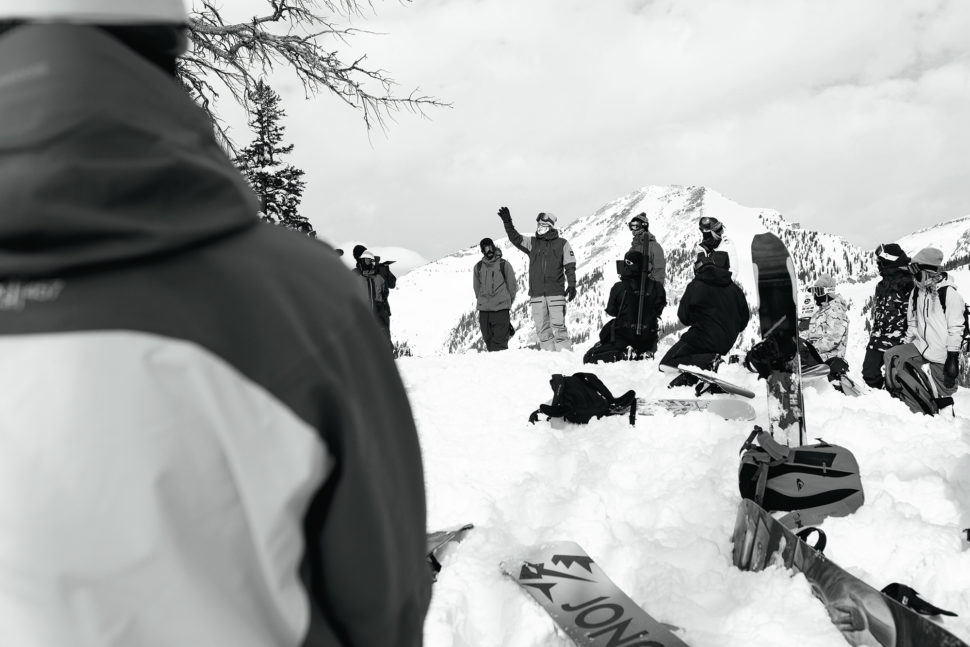
TR: Everyone at that event is a really interesting individual and being able to focus, even if it’s just for a couple of rounds, on specific riders, it allows the hosts to have time to share more about who these people are and it gives the riders more time to come across to the fans. At the end of the day, being able to be an open platform for riders to share more about themselves is crucial to our success moving forward. We’re not in the business of trying to skew the conversation or hype some riders more than others. We want people to rise naturally and fans to identify with the riders that they feel drawn to. Through this format, that’s possible. Plus, it’s way easier to bet on.
LG: And the camaraderie is really unique, I think. In snowboarding, everybody’s bros, right? Everyone hugs it out at the bottom of the pipe and everybody cheers for everyone else’s success. But I think for the riders who spend a lot of time in backcountry, the shared experience is so important because that’s how you get beta about what you’re riding and how you stay as safe as possible. That mentality is so collaborative and I think that was really evident in each event. You want everybody to perform at their best. You don’t want to win because someone else lost, you want to win because you rode to the best of your ability, and you want to enable everybody else to do that too.
TR: The other thing was that I really wanted an event that had a lot more riding. I didn’t want anyone on a podium to get there just through luck. Not that anyone would, but you know what I’m saying—I wanted the podiums to be completely questionless. Whoever got there earned their way there through multiple rounds of head-to-heads. And as a rider, I loved the component of having to ride more than a single line in the venue. I don’t think anyone that ended up on the podium rode the same line. You have to switch it up as conditions change, as the event changes. And last year in Jackson, another thing I don’t think people are totally aware of, we got a really unique opportunity to ride the entirety of the venue twice. Most years, we’re likely going to break the venue in half because of snow conditions—ride one half, and then the other half. I would say that last year was like a one-out-of-five-year type of occurrence being able to run the whole venue twice.
AS WE GOT FURTHER INTO IT, WE REALIZED THAT WHAT WAS MOTIVATING US TO DO THIS WAS BEING ABLE TO HAVE THESE EDUCATIONAL COMPONENTS TO GIVE BACK AND FURTHER INSTILL A SENSE OF RESPONSIBILITY AND STEWARDSHIP.
— TRAVIS RICE
LG: Going into Jackson for this next year, it’s all about being prepared for whatever Mother Nature throws at us. Really filling out the course because statistically, the scenario that presented itself last year, where we had a bluebird day with good stability, multiple days of snow to bury all those tracks, and then another bluebird day with good stability, that was about a 10% chance of that happening. This year, we’re preparing for the other 90%. If we do need to run left side one day and right side the other days, we have enough features on both sides that we have fully legit, separate venues that can hold a full day worth of riding each.
TR: There will be both new features and there will be better features than the ones that we had last year. For example, there were a lot of landings and features that we had just made out of snow that were pretty average frankly, and so we got to build them out proper this past summer. I’m looking outside right now and there’s snow on the ground in the valley. I’m thinking about the crew that’s out there working today in the snow, and the fact that they probably have three weeks of work left. Our crew’s a bunch of bad boys and girls. I was just up there last week, and they’re doing such a good job. And it’s not easy work. Every day that crew goes up there to work, blood is drawn. And I mean that literally: Every day, somebody bleeds. I guarantee you it’s the same for Canada, too. The crew has been working on the course at Baldface and trying to assemble timber framing on these types of slopes. The hauling of material, the ruggedness of the terrain, the tools that are needed—every day someone’s getting a shinner or someone’s freaking smashing a finger. The crew is just made up of badass lumberjacks who are also riders. I’m really excited for Scary Cherry. We’re planning to end the event on the bench where the jump used to be, so we’re not doing the whole lower section. Before, we had run times in the two minutes-plus range, which was psycho. The venue itself was over a mile long. It was too much, trying to hold it together for that long. People had to hold back and that’s not in the spirit of the event. So the goal with this year’s event at Baldface is, “All right, you got multiple attempts, multiple runs. Let’s send it.” It’s going to be fun. We’ve got a couple of aces up our sleeve with the BC venue that we’re not disclosing at this point, but it all should be pretty sweet.
I THINK YOU BECOME AWARE OF YOUR POWER, AND RESPONSIBILITY, AND THE IMPACT THAT WE ALL HAVE AS YOU GET A LITTLE OLDER, AND IT BECAME VERY APPARENT THAT THE MOST IMPORTANT PART OF WHAT WE WERE DOING WAS ACTUALLY NOT THE SNOWBOARDING. IT WAS THAT WITH THE SNOWBOARDING, WE CAN CREATE THE RELEVANCY AND THE IMPORTANCE TO TUNE IN.
— TRAVIS RICE
LAUNCH
THERE’S ONLY ONE FIRST TRACK. I REMEMBER IT FROM EVERY EVENT. IT WAS AUSTEN SWEETIN FOR THE TEST EVENT. IT WAS SCOTTY LAGO FOR SUPERNATURAL. IT WAS PAT MOORE FOR ULTRA NATURAL. THAT FIRST TRACK AT A POWDER-BASED EVENT SETS THE TONE FOR EVERYONE.
— LIAM GRIFFIN
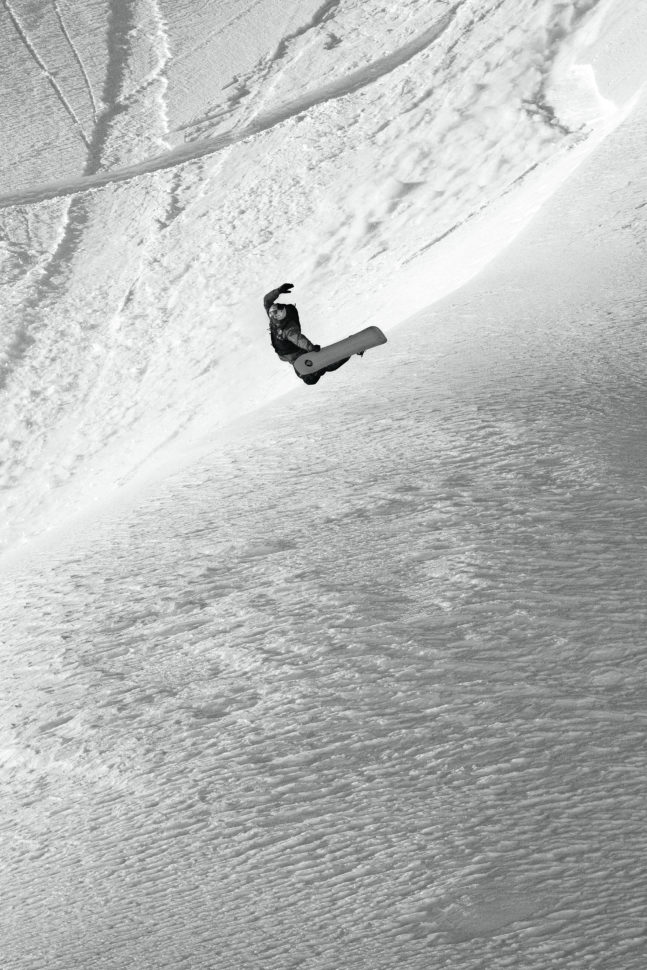
LG: There’s only one first track. I remember it from every event. It was Austen Sweetin for the test event. It was Scotty Lago for Supernatural. It was Pat Moore for Ultra Natural. That first track at a powder-based event sets the tone for everyone. For me, it was the night before, when Gigi picked to go first at the bracket draw—because at a really basic level, nobody wants to go first, nobody wants to go last, and nobody wants to go against Travis, right? Those are the three spots you don’t want. When Gigi said he was going to drop first, I was like, yes. If there’s anybody who can lace this thing it’s that dude. And that front seven is legendary and will remain legendary for as long as we’re doing this event, maybe longer. Because after seeing that, everybody knows the speed’s good, the snow is good. In Alaska, it’s like when Rasman dropped in and cleaned it top to bottom, and then got on the radio and gave everybody a heads up on what the snow was like and what the speed was like.
TR: This past year, I really debated if I was even going to ride in the contest. I ended up deciding that being able to drop in was the bonus for me for all the work that led up to it. Leading up to the event, I intentionally did not ride the course because I already had an unfair advantage since I designed the venue. So, getting to actually drop in with good conditions and put a run down the course was a special thing, just for the years of work that had gone into building it. On the second day, I went out of my way to ride the lines that people weren’t riding because there were features that we had put a ton of time and effort into that weren’t getting hit. So I was like, “All right, I’m riding the line that’s not getting ridden just to makes sure that none of that work was for nothing.”
LG: In Alaska, Travis couldn’t be there because his partner, Brook, was due to have their baby on the day we had planned to have the event. Travis not being there was terrifying, because the number one thing that I could do to fuck it up would be to disappoint him.
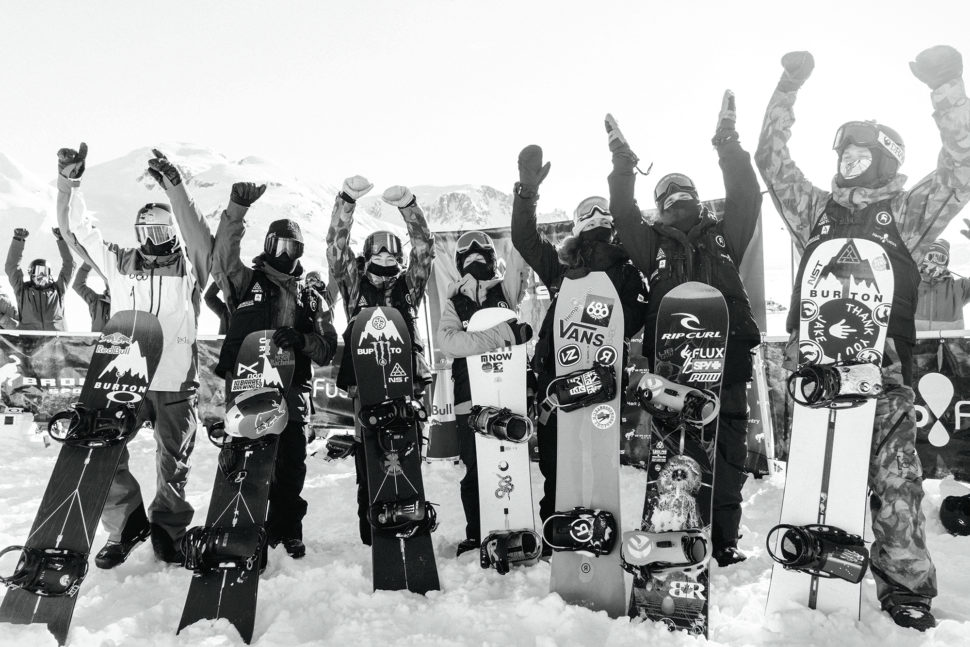
TR: Early on we saw the universal sarcasm when Brook and I were given a due date of March 20th and the event was on the exact same date. But Liam is the type of guy who doesn’t go into an event without it being completely done and planned out. So, I just stayed open to it. I had a seat up in AK in case it felt like it was okay to go up or if we had Jupiter early and everything was great—in hindsight, I don’t know if I would’ve left even if everything had gone perfectly. But it was serendipitous. A lot happened in the last year.
LG: So, Rasman was my eyes and ears. Travis trusted him. The morning that the crew flew into Tordrillo Mountain Lodge, Rasman and I flew in a heli directly to the venue to scope snow conditions. We had a three way Zoom—me, Trav and Rasman—about where we were going to go, what we were going to do, what we should be looking for. Once we figured it all out, found the spots, scoped the angles, we were like, “All right. There’s going to be a camera here and here and here, the drop-in is going to be here, and the heli pickups going to be here”. And then it all happened. The morning of the finals, Rasman was the first one to drop, which was kind of insane that it just worked out like that.
I literally have goosebumps thinking about it. It was just one of the most incredible things I’ve ever experienced in my life. I felt like everything I had done in my entire career led to that moment in Alaska and it went just fucking perfect. Because there was no other way for it to go. It had to be perfect.
TR: So, Jupiter was just chilling. He was late. March 21st, March 22nd, March 23rd—I think the event wrapped on the 23rd. Brook and I were at the National Wildlife Museum in Jackson and I kept getting this unmarked phone call. Finally, I was like, “What the fuck is this?” I answered it real quick and it was satellite call from the glacier. Epic. I ran outside, talked with Robin and Mikkel and found out what went down. Everyone was so psyched how well it went and I was just over the moon. I was like, “Yes. Everyone’s good. The event ran really smooth. Fuck yeah.” I hung up the phone, I walked inside, and found Brook back in the museum and she had this look on her face. She said, “I’m having contractions.” Jupiter waited to the last minute before he was like, “All right, I’m ready.”
This year in AK, we’ve got an entirely new venue. Look, it’s tricky. There are so many amazing locations in Alaska. I don’t want this story to mislead anybody that the Tordrillos are necessarily better than other places in Alaska. Alaska is such a unique place, so wherever the conditions are good at the time is basically where Alaska is the best. I think the reason we wanted to run it in the Tordrillos last year was when it came down to it, that was the paramount place. The couple of venues in that area that we selected were safe to run events on because they didn’t have massive bergschrunds at the bottom, there wasn’t major glacier, and the lines are pretty planar. I chose venues that weren’t as steep as true Alaska spine freeriding because frankly, that shit is not really conducive to what we’re trying to make happen. For a great men’s and women’s event where we can lap the venue and have the conditions stay intact, super high-pitch, super steep faces are a little less likely to have good or great conditions for a longer period of time. Also, this was the first year. I didn’t want to come out the gates with some psycho, spicy face that potentially some riders might straight up say, “I don’t know if I even want to do this.” So I thought this area of the Tordrillos was a great venue for the first year, but goddamn, I’m really excited because got a bigger, better, badder venue for this year’s event.
CONTINUED EVOLUTION
LG: This thing only works if people care about it. It became obvious that people did care, which was a great feeling. It validated a lot of work that had gone into it. It was obvious that we were bringing something that not just the snowboarding world wanted and needed, but that the broader winter sports audience was really interested in. It’s a trip. Every day, I get up and I’m like, “All right, what are we going to do today to keep moving the ball down the field?” because there’s just so much more to do. This is really just the beginning, even though we’ve got a year under our belt. Hopefully, we can build the NST into a sustainable thing that has a future and is around for snowboarding as long as snowboarding needs it.
TR: I think Liam and I are awesomely different people that are so aligned in our passion and drive through our commitment to snowboarding; we complement each other really well because we’re so different. We have a mutual respect, where he’s patient enough to hear me out on my crazy ideas and I’m patient enough to hear him out when he says, “Hey, this is the only way that we’re going to pull this thing off.” We have a really good checks and balances system.
LG: Yeah. It’s a very good yin and yang. I am super conservative, super dialed, and detailed and just need to feel like I’m in control all the time. Travis is pushing the envelope to the edge of what’s possible at all times. I’m pulling back, he’s pushing forward, and we end up in a happy place with something that is doable, on time and on budget, and safe. Those are all the things that I have to figure out.
CW: You have two people at the absolute extreme opposite ends of the spectrum. But quite literally. I think that’s also why it’s such a great partnership.
TR: It’s not easy for me to sum up one common motivating factor for all of this because, in my own pure selfishness, I just want there to be an event like this. This is me wanting there to be a showcase for this type of riding and wanting to compete in it. Then there’s also the component that snowboarding’s given me so much and I was in a unique position to push this thing into fruition. That seemed like the right thing to do—leave any relationship better than you found it. This was like trying to leave something in snowboarding. Because even if we just did the Natural Selection in 2008 or if we just did the Supernatural in 2012, or even if we just did last year’s event in Jackson, you can’t unsee that and you can’t erase what that was. This is the place that I think snowboarding’s always been going and it hadn’t been done yet because it’s really fucking hard, it costs a lot of money, and you need certain technology to pull it off. So, it’s taken the time it has. Of course, this event wouldn’t be shit without all the other riders showing up to be a part of it, competing at this event, and taking the time out of their season.
I’m passionate about the creation of the venues, finding the locations, and making these large-scale art pieces. That truly is it for me—the large scale, megalithic fine-art installation that is Natural Selection. Really, that’s what it is. The art component of this is so dynamic because of the interaction; you can create such a sculptural piece that then pushes the most fluent riders on the planet to dance with it and to find rhythm with it.
The whole beauty of Natural Selection is the interaction that comes out of it. I really love that part. I somehow have managed to love that enough, that I can stomach all of the phone calls and the fucking meetings and the amount of office time that I have taken on in the last couple of years. As long as that ratio stays net positive to the time I spend in the mountains, I think we’ll be pushing this interaction forward for a long time.
